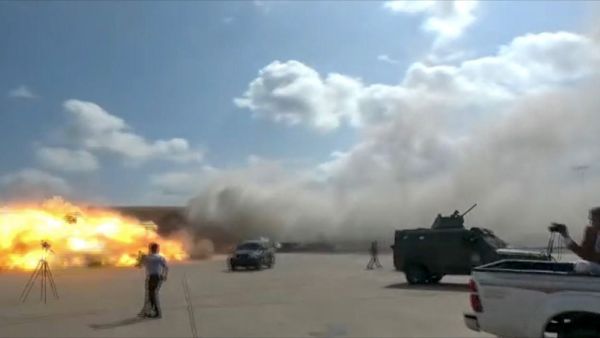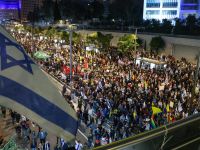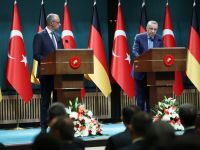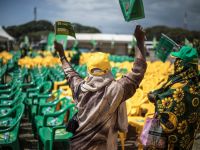At least 26 people were killed and dozens wounded Wednesday in blasts that struck Yemen’s Aden airport after a plane carrying a new unity government landed, a medical source said.
A medical source told AFP in Aden, the temporary capital of Yemen’s internationally recognised government, that there were “at least 26 dead” in the explosions that took place at the airport, while more than 50 people were wounded.
Explosions rock Aden airport, killing at least 22, as new Yemen government arrives https://t.co/ZTb2uThPGz
— The Washington Post (@washingtonpost) December 31, 2020
Some officials said the blasts were a “cowardly” attack by Iran-backed Houthi rebels.
Although all government ministers were reported to be unharmed, more than 50 people were wounded, medical and government sources told AFP in the southern city, with the casuality toll feared likely to rise.
Doctors Without Borders (MSF) said it was preparing a “mass casualty medical response plan”.
As smoke billowed out of the airport terminal from an initial blast, with debris strewn across the area and people rushing to tend to the wounded, a second explosion took place.
Video footage appears to show missile-like ordnance striking the airport apron — that moments before had been packed with crowds — and exploding into a ball of intense flames.
It was not immediately clear what had caused the explosions.
Sporadic gunfire was heard soon after.
Yemen’s internationally recognised government and southern separatists formed a power-sharing cabinet on December 18, forging a joint front against the Houthi rebels who have seized the capital Sanaa and much of the north.
Both Yemeni Information Minister Moammar Al-Eryani and Prime Minister Moeen Abdulmalik Saeed said that all the members of the government were safe.
“We assure our great people that members of the government are fine, and we assure you that the cowardly terrorist attack by the Iran-supported Huthi militia will not deter us from carrying out our patriotic duty,” Eryani said on Twitter.
– ‘Unacceptable act of violence’ –
Saeed tweeted that the “terrorist attack… was part of the war waged against Yemen and its people”, but stopped short of accusing the Huthi insurgents.
Yemen’s government spokesman Rajih Badi called for an international investigation into the “terrorist” attack he said targeted “all members of the cabinet”.
“It is too soon to accuse any party before an investigation reveals who executed the attack, including (accusing) the Huthis,” he told AFP, adding those injured included civilians, security guards and local officials.
Meanwhile, UN envoy Martin Griffiths condemned the attack on Twitter, calling it an “unacceptable act of violence”.
“I wish the cabinet strength in facing the difficult tasks ahead,” he said. “This unacceptable act of violence is a tragic reminder of the importance of bringing Yemen urgently back on the path towards peace.”
The cabinet members including Prime Minister Maeen Abdulmalik, as well as Saudi Ambassador to Yemen Mohammed Said al-Jaber, were transferred safely to the city’s presidential palace, the witnesses and Saudi media said.
A local security source said three mortar shells landed on the airport’s hall.
The newly formed cabinet unites the government of President Abd Rabbo Mansour Hadi with Southern Transition Council (STC) members based on the Riyadh Agreement. The two groups are the main Yemeni factions in a southern-based, Saudi-backed alliance, fighting against the Iran-aligned Houthi movement that controls the north.
Saudi state television Ekhbaria showed destroyed vehicles and smashed glass. Plumes of white smoke rose from the scene.
The southern port city of Aden has been mired in violence because of a rift between the STC and Hadi’s government.
Blasts hit Yemen’s Aden airport as new unity government arrives https://t.co/dSF2j66KXE pic.twitter.com/evUrb7skNe
— Al Jazeera News (@AJENews) December 31, 2020
The Saudi-led coalition announced earlier this month the new power-sharing cabinet that would include the STC.
The cabinet landed from Riyadh where both parties negotiated for more than a year with Saudi mediation before reaching agreement.
Hadi’s Saudi-backed government was at war with with Iran-allied Houthi rebels, who control most of northern Yemen as well as the country’s capital, Sana’a.
Last year, the Houthis fired a missile at a military parade of newly graduated fighters of a hostile militia at a military base in Aden, killing dozens.
— Prior warnings —
Yemeni sources have warned in recent days against Qatar and Turkey-linked groups attempting to disrupt the agreement between the Hadi government and the STC.
On Sunday, unknown gunmen in the Sheikh Othman area in Aden city assassinated Major Nader al-Sharjabi, the procurement official in the National Resistance, led by Brigadier General Tariq Saleh.
Observers believe the assassination was part of a plan aimed at spreading chaos in the interim Yemeni capital and confusing the government’s plans, by driving a wedge between the National Resistance forces on the western coast and the Security Belt Forces, a paramilitary force based in Southern Yemen that forms the elite military wing of the Southern Transitional Council, which is responsible for maintaining security in Aden.
Security reports earlier indicated the presence of a number of cells affiliated with Qatar and the Muslim Brotherhood, which have been operating cautiously in some areas of Aden, where there were sporadic clashes between security forces and some armed elements trying to entrench themselves in densely-populated neighbourhoods densely populated.
Earlier this week, local sources told The Arab Weekly that Qatar-backed tribal and military leaders are trying to mobilise forces from the Shaqra area to deploy them to Qatar-sponsored camps that were created in Qarn Al-Kallassi area under the leadership of Sheikh al-Qibli and a member of the Shura Council, Ali Salem al-Qafish.
The sources also indicated that a Muslim Brotherhood militia in Shabwa had been painting the kits of the so-called National Army units with the colours of the Shabwa Special Forces, as part of their efforts to skirt the military part of the Riyadh Agreement, which stipulates the withdrawal of those forces from Shabwa.
The sources indicated that former Interior Minister Ahmed al-Maysari and former Transport Minister Saleh al-Jabwani, in addition to the Muslim Brotherhood leader Hammoud al-Mikhlafi and the tribal Sheikh Ali Salem al-Huraizi, are overseeing the upcoming escalation plan targeting primarily the governorates of Aden, Lahj, Taiz and Shabwa.
This article has been adapted from its original source.








